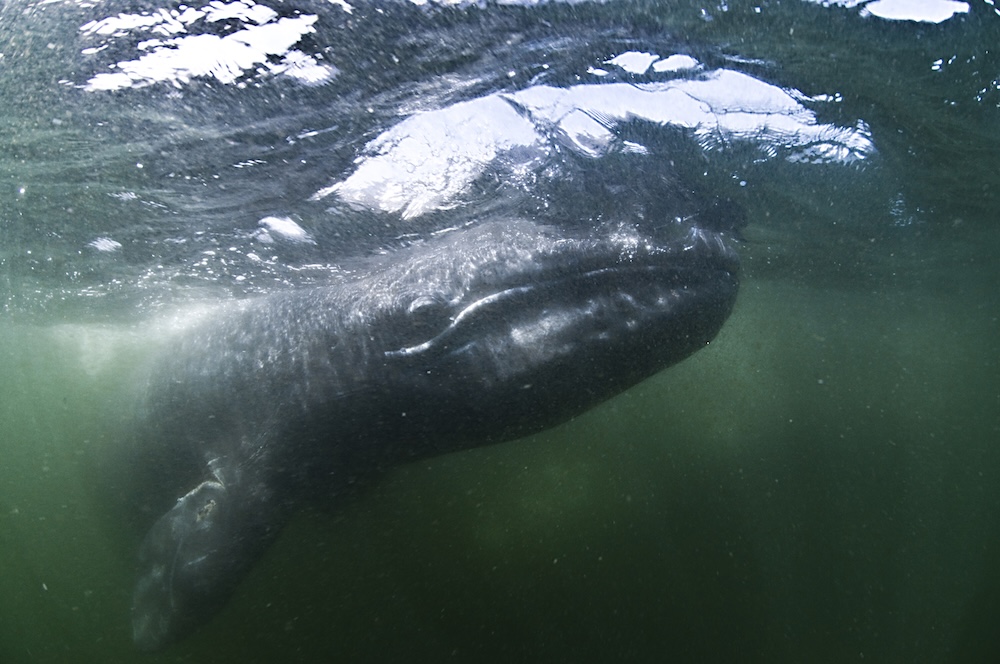They have been crossing oceans since the Ice Age, outliving empires and surviving ice sheets. Yet in 2025, gray whales — the “devilfish” once hunted nearly to extinction — face a new gauntlet of human-made threats that could push them back toward collapse.
From California’s iconic coastline to the icy edges of the Arctic, these 40-foot-long travelers are colliding with ships, starving from vanishing prey, and navigating increasingly noisy and polluted seas. The gray whale’s story is one of resilience — but the clock is running out.
A Population in Decline
Once abundant across the Northern Hemisphere, gray whales were driven extinct in the Atlantic by whaling in the 18th century. Only the Pacific population remains, split into two groups: the Eastern North Pacific (ENP) and the critically endangered Western North Pacific (WNP).
The ENP population rebounded after commercial whaling bans, peaking at around 27,000 in 2016. Today, estimates hover closer to 14,500 — a staggering drop of nearly 50% in less than a decade, according to the National Oceanic and Atmospheric Administration (NOAA).
The smaller WNP group, found near Russia and parts of Asia, numbers only about 200 individuals. Every loss is a devastating blow.
Why the Decline Is Happening Now
Ship Strikes: Fast Lanes Through Feeding Grounds
Collisions with large vessels are a leading cause of death for gray whales, especially in California’s heavily trafficked coastal waters. Their migration routes overlap with some of the busiest shipping lanes in the world, including the approaches to Los Angeles, Long Beach, and San Francisco Bay.
A whale struck at speeds over 15 knots has an almost 80% chance of dying from the collision. And while voluntary slowdown programs exist, enforcement is weak, and compliance rates vary.
Entanglement in Fishing Gear
Crab pots, gillnets, and other fixed gear pose another lethal hazard. Entangled whales can drag heavy lines for months, leading to exhaustion, starvation, or drowning. NOAA data show that between 2010 and 2024, hundreds of gray whales have been reported entangled along the U.S. West Coast — and those are just the cases documented.
Climate Change and Prey Loss
Gray whales feed on small crustaceans like amphipods, scooping them from the seafloor in Arctic feeding grounds. Warming seas and melting ice are reshaping these ecosystems, reducing prey abundance. Scientists believe recent Unusual Mortality Events (UMEs) — years with unusually high deaths — may be linked to whales arriving in poor body condition after long migrations.
Noise Pollution
Constant noise from ships and industrial activity interferes with gray whales’ ability to communicate, navigate, and detect threats. Chronic noise can mask the sound of approaching vessels, making collisions more likely.
Pollution and Habitat Degradation
Plastic debris, chemical runoff, and oil spills contaminate coastal habitats. While gray whales are filter feeders, pollutants accumulate in their prey, entering the whales’ systems over time.
Policy Gaps and Corporate Convenience
Despite decades of marine conservation laws, gray whales remain unprotected from many high-risk human activities. The Marine Mammal Protection Act prohibits harassment and harm, but its enforcement against industries is limited.
Shipping companies often cite “operational needs” to avoid speed restrictions, while fishing interests resist seasonal closures to protect migrating whales. In many cases, government agencies bow to industry lobbying, delaying stronger regulations.
Why Gray Whales Matter
Gray whales are not just another marine species — they are ecosystem engineers. By stirring up seafloor sediments while feeding, they recycle nutrients and stimulate plankton growth, benefiting countless other species.
They are also cultural icons, central to the traditions of Indigenous communities along the Pacific Rim. Losing them would be a loss of biodiversity, heritage, and a vital part of the ocean’s life-support system.
What’s Being Done — and Where It Falls Short
Some progress exists. Voluntary Vessel Speed Reduction (VSR) programs in California encourage ships to slow down in whale hotspots. Rescue teams respond to entangled whales, and satellite tracking helps monitor migrations.
However, without mandatory speed limits, seasonal fishing closures, and global cooperation, these efforts will remain too little, too late.
What Must Happen Now
- Make 10-knot vessel speed limits mandatory in known whale habitats, year-round.
- Expand and enforce seasonal fishing gear restrictions, including ropeless fishing technology.
- Fund Arctic ecosystem monitoring to track prey availability and climate impacts.
- Mandate real-time vessel alerts based on acoustic and satellite whale tracking data.
- Create international agreements to protect migratory corridors across national boundaries.
Final Thoughts
The gray whale has survived ice ages, predators, and centuries of hunting. But no species — not even one as resilient as this — can withstand the combined pressures of industrial shipping, fishing, and climate disruption without meaningful change.
Twenty-five years from now, gray whales could still be a living testament to nature’s endurance. Or they could join the list of ocean giants we remember only in photographs and fossils. Which future we choose depends on whether we act now — and whether we are willing to put life above convenience.









Reader Interactions